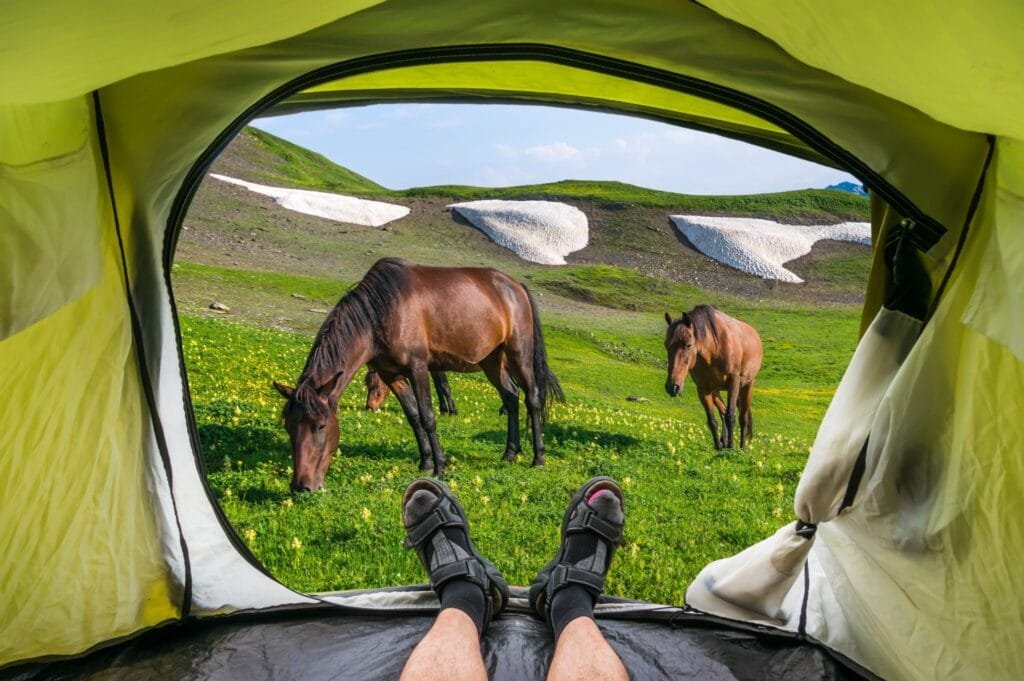Horse camping in the rain can seem challenging, but with the right preparation, it can be a fun and rewarding experience.
Whether you’re a seasoned rider or new to the adventure, understanding how to handle camping with your horse in rainy conditions will ensure you stay safe, comfortable, and dry. Here are some essential tips to help you enjoy your horse camping trip, even when the weather isn’t on your side.
1. Prepare for Wet Weather: Pack the Right Gear
When camping in the rain, being prepared is key. The right gear will make a big difference in your comfort and your horse’s well-being.
For you:
- Waterproof Clothing: Invest in high-quality waterproof clothing, such as a rain jacket, pants, and boots. This will keep you dry and warm during long rides or while setting up camp.
- Dry Bags: Store your clothes, food, and other essentials in waterproof bags or dry sacks. This ensures that your gear stays dry, even if your tent or saddlebag gets wet.
- Tent with a Rainfly: A tent with a good rainfly (a waterproof cover for the tent) will provide extra protection from the rain. Make sure the tent has proper ventilation to avoid moisture buildup inside.
- Waterproof Saddle and Gear: Your horse’s tack, like saddles and saddlebags, should be made of materials that can withstand the rain. Consider using rain covers for saddles and saddlebags to protect your gear.
For your horse:
- Horse Blanket or Rain Sheet: A waterproof horse blanket or rain sheet will keep your horse dry and comfortable in the rain. Make sure it fits properly to avoid any chafing.
- Hoof Care: Keep an eye on your horse’s hooves, especially after long periods in wet conditions. Wet, muddy terrain can cause hooves to soften or develop thrush. Carry hoof picks and other hoof care tools to keep your horse’s hooves clean and dry.
- Horse Booties: If the ground is particularly muddy or slippery, horse booties can help protect your horse’s hooves from excessive wear.
2. Choose the Right Campsite
Selecting a good campsite is essential when horse camping in the rain. You want to avoid low-lying areas where water can pool, and make sure the area is safe for both you and your horse.
- High Ground: Look for higher ground to set up your campsite. This will help prevent flooding in your tent and ensure your horse stays dry and safe.
- Sheltered Areas: If possible, find a sheltered spot with some natural cover, like trees or hills, that can offer protection from the rain and wind.
- Good Drainage: Choose a spot with good drainage to avoid mud. Steer clear of marshy areas, which can become slippery and difficult to navigate for both you and your horse.
3. Take Care of Your Horse During the Rain
Keeping your horse comfortable and healthy in the rain is crucial. Horses can be sensitive to wet weather, so you need to manage their well-being carefully.
- Monitor Their Comfort: If your horse becomes too wet and cold, it may start to shiver. Ensure they have a waterproof blanket or rain sheet to stay warm and dry. If the weather worsens, consider bringing your horse into a covered area like a barn or stable if one is available.
- Keep Them Hydrated: Even in the rain, your horse needs access to clean, fresh water. Make sure to carry enough water or have access to a nearby stream or water source.
- Avoid Overexertion: Riding in the rain can be physically demanding, both for you and your horse. Ensure you don’t overexert your horse by planning shorter rides or taking frequent breaks. Muddy and slippery conditions can also increase the risk of injury, so keep your pace slow and steady.
4. Create a Comfortable Campsite for Your Horse
Your horse will need a safe and dry place to rest overnight, so ensure your campsite is horse-friendly.
- Portable Horse Shelter: Consider bringing a portable shelter, such as a small tarp or pop-up tent, for your horse. This provides a dry area where they can stand and rest, especially if there are no natural shelters around.
- Muddy Conditions: If the ground becomes too muddy, consider using mats or hay to create a dry spot for your horse to stand on. This can help prevent mud buildup on their hooves and provide a cleaner resting area.
- Feed and Hay: Make sure to bring enough feed and hay to last your horse through the trip. Wet weather can make finding dry forage difficult, so packing extra hay is always a good idea.
5. Safety and Trail Considerations
When riding in the rain, the trails may become slick and more challenging to navigate. Be extra cautious of slippery surfaces, falling branches, and washed-out trails.
- Slow and Steady Pace: Keep a steady, slower pace when riding in the rain. This will help you maintain control of your horse and reduce the risk of slipping on slick terrain.
- Check Trail Conditions: Before riding, check trail conditions and weather reports. Be aware of any flood warnings, mudslides, or trail closures that could affect your ride.
- Visibility: If the rain is heavy, visibility may be poor. Consider wearing brightly colored clothing and reflective gear for both you and your horse to stay visible to others on the trail.
6. Know When to Call It Quits
Sometimes, the rain can become overwhelming or even dangerous. If the weather becomes too severe, don’t hesitate to call it quits and find shelter for both you and your horse. Lightning, heavy winds, and extreme downpours can pose risks, so always prioritize safety over continuing your adventure.
Final Thoughts
Horse camping in the rain can be an enjoyable and unique experience, but it requires careful planning and preparation. By choosing the right gear, campsite, and strategies to care for both you and your horse, you can make the most of your rainy adventure. With the right mindset and precautions, rainy camping can be an exciting challenge that strengthens your bond with your horse and creates lasting memories.




